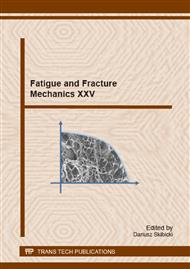[1]
R. Litwinko, W. Oliferuk, Yield Point Determination Based On Thermomechanical Behaviour Of Polycrystalline Material Under Uniaxial Loading, Acta Mechanica et Automatica, 3 (2009), 49-51.
Google Scholar
[2]
A. Lipski, The use of passive infrared thermography for tests of materials and riveted joints used in aviation industry- selected problems. Part II of the collection of monographs (edited by J. Szala): Experimental methods in studies of materials and riveted joints used in aviation industry - selected problems. Institute For Sustainable Technologies – National Research Institute in Radom, Bydgoszcz-Radom, 2010 (in Polish).
Google Scholar
[3]
A. Lipski, Impact Of The Strain Rate During Tension Test On 46Cr1 Steel Temperature Change, Key Engineering Materials, 598 (2014), 133-140.
DOI: 10.4028/www.scientific.net/kem.598.133
Google Scholar
[4]
M. Poncelet et al., Probabilistic multiscale models and measurements of self-heating under multiaxial high cycle fatigue, Journal of Mechanics and Physics of Solids, 58, 4 (2010), 578–593.
DOI: 10.1016/j.jmps.2010.01.003
Google Scholar
[5]
C. Doudard et al., Determination of an HCF criterion by thermal measurements under biaxial cyclic loading, International Journal of Fatigue, 29, 4 (2007), 748–757.
DOI: 10.1016/j.ijfatigue.2006.06.009
Google Scholar
[6]
A. Lipski, D. Skibicki, Variations Of The Specimen Temperature Depending On The Pattern Of The Multiaxial Load - Preliminary Research, Materials Science Forum, 726 (2012), 162-168.
DOI: 10.4028/www.scientific.net/msf.726.162
Google Scholar
[7]
A. Lipski, D. Boroński, Use of Thermography for the Analysis of Strength Properties of Mini-Specimens, Materials Science Forum, 726 (2012), 156-161.
DOI: 10.4028/www.scientific.net/msf.726.156
Google Scholar
[8]
G. La Rosa, A. Risitano, Thermographic methodology for rapid determination of the fatigue limit of materials and mechanical components, International Journal of Fatigue, 22, 1 (2000), 65–73.
DOI: 10.1016/s0142-1123(99)00088-2
Google Scholar
[9]
G. Meneghetti, Analysis of the fatigue strength of a stainless steel based on the energy dissipation, International Journal of Fatigue, 29, 1 (2007), 81-94.
DOI: 10.1016/j.ijfatigue.2006.02.043
Google Scholar
[10]
M.P. Luong, Fatigue limit evaluation of metals using an infrared thermographic technique, Mechanics of Materials, 28, 1 (1998), 155–163.
DOI: 10.1016/s0167-6636(97)00047-1
Google Scholar
[11]
F. Cura, G. Curti, R. Sesana, A new iteration method for the thermographic determination of fatigue limit in steels, International Journal of Fatigue, 27, 4 (2005), 453–459.
DOI: 10.1016/j.ijfatigue.2003.12.009
Google Scholar
[12]
X.G. Wang, V. Crupi, X.L. Guo, Y.G. Zhao, Quantitative Thermographic Methodology for fatigue assessment and stress measurement, International Journal of Fatigue, 32, 12 (2010), 1970–(1976).
DOI: 10.1016/j.ijfatigue.2010.07.004
Google Scholar
[13]
G. Fargione et al., Rapid determination of the fatigue curve by the thermographic method, International Journal of Fatigue, 24, 1 (2002), 11–19.
DOI: 10.1016/s0142-1123(01)00107-4
Google Scholar
[14]
H. Jiang et al., Experimental investigations on kinetics of Portevin–Le Chatelier effect in Al–4wt. %Cu alloys, Journal of Alloys and Compounds, 428, 1-2 (2007), 151–156.
DOI: 10.1016/j.jallcom.2006.03.062
Google Scholar
[15]
S. P. Joshi et al., On the Occurrence of Portevin–Le Châtelier Instabilities in Ultrafine-Grained 5083 Aluminum Alloys, Experimental Mechanics, 49, 2 (2009), 207–218.
DOI: 10.1007/s11340-008-9208-3
Google Scholar
[16]
H. Ait-Amokhtar et al., The dynamics of Portevin–Le Chatelier bands in an Al–Mg alloy from infrared thermography, Materials Science and Engineering: A, 488, 1-2 (2008), 540–546.
DOI: 10.1016/j.msea.2007.11.075
Google Scholar
[17]
H. Louche, P. Vacher, R. Arrieux, Thermal observations associated with the Portevin–Le Châtelier effect in an Al–Mg alloy, Materials Science and Engineering: A, 404, 1-2 (2005), 188–196.
DOI: 10.1016/j.msea.2005.05.058
Google Scholar
[18]
R. Nogueira et al., Spatial and Temporal Characteristics of Propagating Deformation Bands in AA5182 Alloy at Room Temperature, Metallurgical and Materials Transactions: A, 42, 11 (2011), 3358–3369.
DOI: 10.1007/s11661-011-0749-1
Google Scholar


